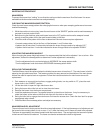
1-32 American-Lincoln
ATS 46-53 Battery
EMPTYING THE DEBRIS HOPPER
1. Remove foot from accelerator and stop the machine.
2. Engage the parking brake.
3. Move the hopper dump door lever to the “CLOSE” position until the door is closed.
4. Move the hopper lift lever to the “RAISE” position until the hopper reaches the desired height.
5. Disengage the parking brake.
6. Drive forward slowly with hopper raised to clear the refuse container before opening hopper dump door.
7. Stop machine and engage the parking brake.
8. Push the hopper dump door lever forward to the “OPEN” position. This will allow debris in the hopper to
fall out into the refuse container.
9. Move the hopper dump door lever to the “CLOSE” position until the door is closed.
10. Release the parking brake.
11. Drive slowly in reverse to clear the refuse container.
12. Stop machine and engage the parking brake.
13. Move the hopper lift lever forward to the “LOWER” position and hold until the hopper is closed.
14. Move the hopper dump door lever to the “OPEN” position until the dump door opens.
WARNING
Do not turn off the machine with the hopper in the lifted position.
NOTE
After stopping the machine, perform these post-operation checks.
POST-OPERATION CHECKLIST
1. Clean the debris hopper.
2. Check sweeping brooms for wear or damage.
3. Check all flaps for wear, damage and adjustment.
4. Check all systems for leaks.
5. Charge and service motive power batteries (see battery charging instructions).
6. Check squeegees for damage.
BATTERY CHARGING INSTRUCTIONS
Charge the batteries at the end of each day or when the battery condition meter indicates low battery voltage.
The batteries need to be charged when the needle stays in the “red” zone while the machine is being operated.
When charging the batteries, only use the quick disconnect provided to ensure correct polarity. Follow the
instructions below.
Check the liquid level in the batteries at least once a week and add water when low. Use only distilled water.
Fill the batteries after charging them to prevent electrolyte from spilling over onto the tops of the batteries
during the charging process.
WARNING
The use of an extension cord with the charger should be avoided. Risk of fire and electrical shock is possible if
the wrong type or size extension cord is used. Locate all cords so they cannot be stepped on, tripped over, or
otherwise subjected to damage or stress.
STORAGE FOR BATTERY-POWERED MACHINES
When batteries are not in use, they will discharge much sooner in cooler temperatures than in warm tempera-
tures. Recharging and storing is more efficient at room temperature.
Do not discharge the batteries excessively (do not go below 80%). Excessive discharge can cause polarity
reversal of the individual cells in the battery. This will lead to complete failure of the batteries.
Use a hydrometer to monitor the specific gravity of the individual cells in the batteries. When checking the
specific gravity of the batteries, you should not see a large difference between the individual cells. The batteries
may need to be replaced if the battery shows a significant difference of specific gravity between the cells.
OPERATING INSTRUCTIONS


















